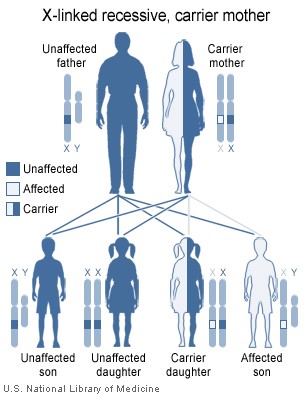Becker's muscular dystrophy
Becker's muscular dystrophy (also known as Benign pseudohypertrophic muscular dystrophy) is an X-linked recessive inherited disorder characterized by slowly progressive muscle weakness of the legs and pelvis. more...
It is a type of dystrophinopathy, which includes a spectrum of muscle diseases in which there is insufficient dystrophin produced in the muscle cells, resulting in instability in the structure of muscle cell membrane. This is caused by mutations in the dystrophin gene, which encodes the protein dystrophin. Becker's muscular dystrophy is related to Duchenne muscular dystrophy in that both relate to the production of dystrophin, but in Duchenne muscular dystrophy no dystrophin is produced, or it is so abnormal that it cannot be recognized as such. Both Duchenne and Becker's muscular dystrophy have traditionally been called "X-linked" recessive diseases, but in view of modern molecular biology and identification of the dystrophin gene, it might be more appropriate to say they are X-chromosome recessive diseases. Becker's is named after the German doctor Peter Emil Becker.
Genetics
The disorder is inherited with an X-linked recessive inheritance pattern. The gene is located on the X chromosome. Since women have two X chromosomes, if one X chromosome has the non-working gene, the second X chromosome will have a working copy of the gene to compensate. In these cases, some women have much milder symptoms because of this ability to compensate. For example, carrier females of mutations are at increased risk for dilated cardiomyopathy. Since men have an X and a Y chromosome and because they don't have another X to compensate for the defective gene, they will develop symptoms if they inherit the non-working gene.
All dystrophinopathes are inherited in an X-linked recessive manner. The risk to the siblings of an affected individual depends upon the carrier status of the mother. Carrier females have a 50% chance of passing the DMD mutation in each pregnancy. Sons who inherit the mutation will be affected; daughters who inherit the mutation will be carriers. Men who have Becker's musculary dystrophy can have children, and all their daughters are carriers, but none of the sons will inherit their father's mutation. Prenatal testing through amniocentesis or Chorionic villus sampling (CVS) for pregnancies at risk is possible if the DMD mutation is found in a family member or if informative linked markers have been identified.
Becker's muscular dystrophy occurs in approximately 3 to 6 in 100,000 male births. Symptoms usually appear in men at about age 12, but may sometimes begin later. The average age of becoming unable to walk is 25-30. Women rarely develop symptoms.
Genetic counseling is indicated for individuals or families who may carry this condition.
Symptoms
- Muscle weakness, slowly progressive (Difficulty running, hopping, jumping; Progressive difficulty walking)
- Ability to walk may continue into adulthood (up to age 40)
- Frequent falls
- Difficulty breathing
- Cognitive dysfunction
- Skeletal deformities, chest and back (scoliosis)
- Muscle deformities (contractures of heels, legs; Pseudohypertrophy of calf muscles)
- Fatigue
- Heart disease
People with this disorder experience progressive muscle weakness of the legs and pelvis, which is associated with a loss of muscle mass (wasting). Muscle weakness also occurs in the arms, neck, and other areas, but not as severely as in the lower half of the body.
Read more at Wikipedia.org



